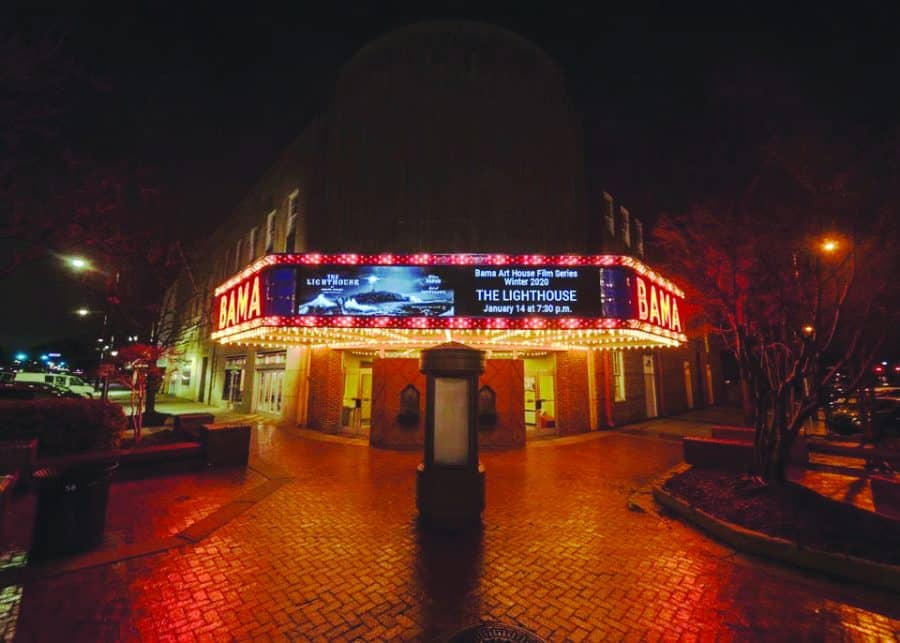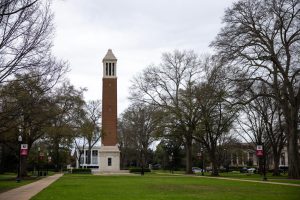Bama brings indie films to Tuscaloosa
January 16, 2020
The winter season of the Bama Theatre’s Arthouse series is here, bringing with it Academy Award-nominated features and shorts that offer a little something for everyone.
It wasn’t laughter, sighs or a leaked squeal that could gauge the audience’s attention at Bama Theatre’s showing of “The Lighthouse,” but the still silences that spoke volumes. The psychological horror starring Robert Pattinson and Willem Dafoe as Ephraim Winslow and Thomas Wake provoked more than a few. Save for crinkling candy wrappers, the quiet audience was captivated by the black-and-white brain-buster of a film.
“‘[The] Lighthouse’ was a lot to take in,” UA professor Alyx Vesey said.
The film, which begins with sparse dialogue and a depiction of a less-than-harmonious mentor/mentee relationship between Winslow and Wake, shows the two lightkeepers caring for the lighthouse. Wake, who ceaselessly puts Winslow to work, once makes his apprentice swab the floor three times in a row. This behavior doesn’t last long, though. As the men slip further and further from sanity, the lighthouse’s condition falls by the wayside.
“What I think we actually witnessed was a descent into madness,” Vesey said. “I very much thought about it, as a professor, in relation to the student/teacher relationship and how not to be a mentor – like maybe what not to do in terms of helping your students reach their full potential.”
While Wake, aided by a monster of a storm, provided the means for the “descent” – alcohol, lack of sleep and isolation – Winslow added coal to the boiler with his irrational need to steal Wake’s keys to the light at the top of the house. The characters’ aberrant behavior incited fear in some instances, but was humorous in others.
The unexpected hilarity of scenes, like the one where a drunken Wake begs desperately and repeatedly that Winslow admits he liked his lobster dinner dish, and others in which Wake farts obtrusively, added a lightness to the otherwise intense film.
“It was an overwhelming experience to be sure, and the performances were really sort of unhinged and wild,” Vesey said. “I’d love to see what the outtakes were like when they were on set, between Dafoe and Pattinson. It’s a funny movie, but it’s just pretty harrowing and crazy.”
Either the most intriguing or the most frustrating part of the film is the fact that it never conclusively satisfies all of the viewers’ questions.
“I think the general point of the story was well-executed. It just leaves you thinking,” said Lauren Cheek, a freshman majoring in criminal justice and psychology. “I have a lot of questions.”
Though the Bama Art House films are screened for only one night, viewers who missed “The Lighthouse” can mark their calendars for Tuesdays at 7:30 to catch the rest of the theatre’s winter series. The next film, “Parasite,” is one Vesey particularly anticipates.
“I think [“Parasite”] is the best movie of the year,” Vesey said. “I think it’s super resonant in terms of class struggle, people trying to make ends meet. It’s also really funny and grounded in family drama. It’s kind of doing a lot of things at once – it’s a pretty well-acted, formally ambitious movie that’s also highly enjoyable and watchable and entertaining. So I’m really excited about that one.”
Despite the ever-expanding opportunity to stream films from home, Bama Theatre manager Jason Armit hopes that the history behind the theatre and the experience of going to it will continue to keep the seats filled. Challenges stemming from these alternate watching platforms test the theatre’s ability to preserve its integrity by screening films. Built in the mid-20th century, the space is a beloved Tuscaloosa landmark that Armit hopes to see maintained.
“I think that in 1937, Tuscaloosa was probably lucky that they were chosen to have it built during the depression with a [Public Works Administration],” Armit said. “Even more so, they’re probably lucky it’s still standing because a lot of theatres in a town like Tuscaloosa, those places are gone.”










